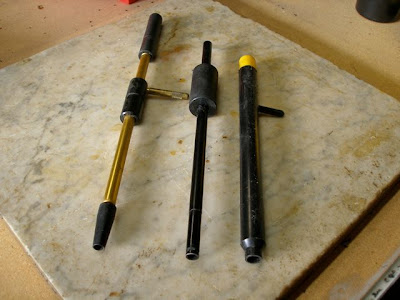No One Will Know The Difference
To your front are two bull elk. If measured, one would score 380; the other 375. Which one do you shoot?
The best hunter armed with the best guide, binoculars, spotting scope and micrometers couldn’t tell the difference between bulls. You would shoot the bull elk that was closest, “looked bigger,” had the best shot at, or had the best angle for a good shot. Neither you, nor the elk will know the difference.
Behind you is a line of four rifle bearers. Each one holds one of the stand-bys for elk hunting--270 Winchester, 280 Remington, 284 Winchester, and a 30-06 Springfield. Which rifle do you choose?
If each of the mentioned rifles were of the same make, model and outfitted with similar sights and sling, neither you, nor the elk will know the difference. That contradicts what is written in magazines and “hunting” forums and chat rooms. There, claims are made that this is bigger, faster, slow, more powerful, less powerful, not as good, blah, blah, blah. I know the argument well, when we were children my brothers and I fought over who got the biggest piece of cake.
Ballistically all four use the same case. The key word there is “ballistically.” Before everyone runs for the comment box and points out the difference between the 270/280/30-06 and the 284, yes, they are different, but ballistically identical. The 280 Remington and the 284 Winchester will shoot bullets of 160 grains and heavier to nearly the same velocity and point of impact. For lighter bullets there will be about a 100 fps difference in velocity, and not much change in impact at normal hunting ranges. The 30-284 wildcat used the same loading data as the 30-06. (Please check you loads and work them up carefully. Don’t take my word for it, but it’s true.)
280 Remington
The 280 had a lot of ground to make up when it was released by Remington in 1957. It’s original ballistic competitor, the 30-06 Springfield had already been around for over 50 years and warehouses full of surplus military ammo remained. Its near ballistic twin, the 270 Winchester, had been out since 1925 and had garnered a following that included Jack “Mr 270” O’Connor.
It was initially available in the Model 740 semi-automatic and later the 750 pump and 721 bolt gun.
It didn’t catch on. I could snort, bellow, paw the dirt, and make claims as to why, but I won’t--I always got the smallest piece of cake.
The 280 case is the 30-06 or 270 case stretched an additional .052 inches longer to ensure it cannot be fired in a 270. The reverse is not true. If you have several rifles, one of which is a 270, take great care when choosing ammunition. Rifles with good extractors can hold the 270 shell rigidly enough in the 280 to cause excessive headspace. Firing could, and probably will, separate the case and do possible damage (and death) to the rifle and the shooter.
In 1979, Remington shot itself in the foot with the 280. Because of lackluster sales, the marketing gurus decided to rename the cartridge the 7mm Express, which people immediately confused with the successful 7mm Remington Magnum. They came to their senses in 1981 and returned to the 280 moniker.
All competing claims of the superiority of the one cartridge over or under the 280 aside, I have seen no difference in the field. Surprisingly, a dead elk is dead regardless of what it was shot with. The only caveat I have for the 280 (and the 284 Winchester) is logistics. Because they have not been as popular as the 270 and ’06, ammunition can be hard to find in back woods gas stations and trading posts. Plan accordingly.
284 Winchester
In 1963, Winchester released the 284 in its Model 100 semi-automatic and Model 88 lever gun. The case was a new design. It features a case body nearly equal to belted magnums, but a rim that fits standard bolt faces. The point of this experiment was to squeeze a 270/280 out of a short action capable of handling 308 length case.
The experiment--as the 284--failed miserably. The warning about logistics on 280 ammunition should be multiplied for the 284. Good Luck!
The case does live on though. It is the basis for many efficient wildcats, most notably, the 6.5-284, which has become the “go to” cartridge for long range target shooting.
The concept of a rebated rim was also used in the Remington Ultra Mags--only scaled up. The RUMs uses a rim that fits a magnum bolt face and a large case body without the belt.
Anyone want to fight over cake?































